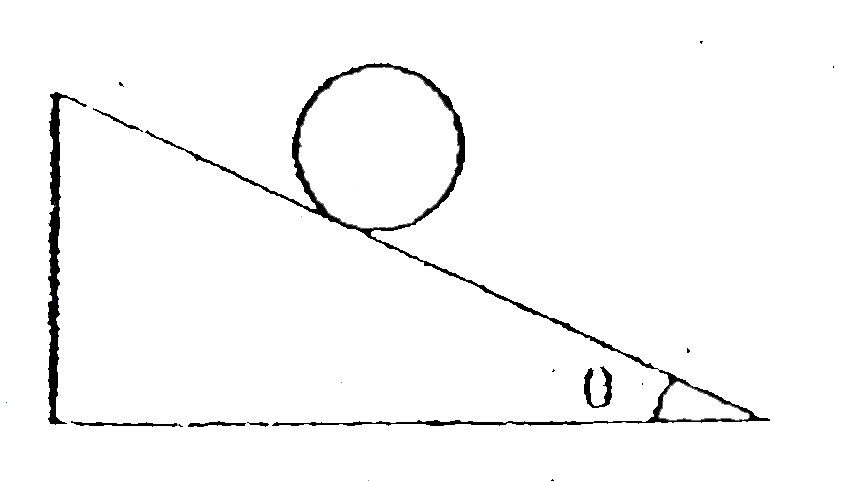An inclined plane makes an angle 30° with the horizontal. A solid sphere rolling down this inclined plane from rest without slipping has a linear acceleration equal to
g3
2g3
5g7
5g14
The correct Answer is:D
To find the linear acceleration of a solid sphere rolling down an inclined plane that makes an angle of 30° with the horizontal, we can follow these steps:
Step 1: Identify the Forces Acting on the Sphere
The forces acting on the sphere include:
- The gravitational force mg acting downward.
- The normal force N acting perpendicular to the inclined plane.
- The component of gravitational force parallel to the incline, which is mgsinθ.
- The component of gravitational force perpendicular to the incline, which is mgcosθ.
Step 2: Break Down the Forces
For an inclined plane at an angle θ=30°:
- The parallel component of the gravitational force is:
Fparallel=mgsin(30°)=mg⋅12=mg2
- The perpendicular component is:
Fperpendicular=mgcos(30°)=mg⋅√32
Step 3: Apply Newton's Second Law
Since the sphere rolls without slipping, we can apply Newton's second law for the linear motion along the incline:
Fnet=ma
Where Fnet is the net force acting along the incline. The net force is the component of gravity acting down the incline minus the friction force (which we will account for through rotational motion).
Step 4: Calculate Torque and Angular Acceleration
The torque τ about the point of contact (point O) due to the gravitational force is:
τ=r⋅Fparallel=r⋅mg2
Using the moment of inertia I for a solid sphere about its center of mass, which is I=25mr2, the moment of inertia about point O (using the parallel axis theorem) is:
IO=I+m⋅r2=25mr2+mr2=75mr2
Step 5: Relate Torque to Angular Acceleration
Using the relationship τ=Iα:
r⋅mg2=75mr2⋅α
Cancelling m and one r:
g2=75rα
Solving for α:
α=5g14r
Step 6: Relate Angular Acceleration to Linear Acceleration
The linear acceleration a of the center of mass is related to the angular acceleration by:
a=αr
Substituting for α:
a=(5g14r)r=5g14
Final Answer
Thus, the linear acceleration of the solid sphere rolling down the inclined plane is:
a=5g14
Conclusion
The correct option is option 4: 5g14.
---
The forces acting on the sphere include:
- The gravitational force mg acting downward.
- The normal force N acting perpendicular to the inclined plane.
- The component of gravitational force parallel to the incline, which is mgsinθ.
- The component of gravitational force perpendicular to the incline, which is mgcosθ.
For an inclined plane at an angle θ=30°:
- The parallel component of the gravitational force is:
Fparallel=mgsin(30°)=mg⋅12=mg2
- The perpendicular component is:
Fperpendicular=mgcos(30°)=mg⋅√32
Since the sphere rolls without slipping, we can apply Newton's second law for the linear motion along the incline:
Fnet=ma
Where Fnet is the net force acting along the incline. The net force is the component of gravity acting down the incline minus the friction force (which we will account for through rotational motion).
The torque τ about the point of contact (point O) due to the gravitational force is:
τ=r⋅Fparallel=r⋅mg2
Using the moment of inertia I for a solid sphere about its center of mass, which is I=25mr2, the moment of inertia about point O (using the parallel axis theorem) is:
IO=I+m⋅r2=25mr2+mr2=75mr2
Using the relationship τ=Iα:
r⋅mg2=75mr2⋅α
Cancelling m and one r:
g2=75rα
Solving for α:
α=5g14r
The linear acceleration a of the center of mass is related to the angular acceleration by:
a=αr
Substituting for α:
a=(5g14r)r=5g14
Thus, the linear acceleration of the solid sphere rolling down the inclined plane is:
a=5g14
The correct option is option 4: 5g14.
Topper's Solved these Questions
- ROTATIONBOOK - DC PANDEY ENGLISHCHAPTER - ROTATIONEXERCISE - (A) Chapter Exercises
83 Videos
- ROTATIONBOOK - DC PANDEY ENGLISHCHAPTER - ROTATIONEXERCISE - (B) Chapter Exercises
25 Videos
- ROTATIONBOOK - DC PANDEY ENGLISHCHAPTER - ROTATIONEXERCISE - Check point 9.2
20 Videos
- RAY OPTICSBOOK - DC PANDEY ENGLISHCHAPTER - RAY OPTICSEXERCISE - Integer type q.
14 Videos
- ROTATIONAL MECHANICSBOOK - DC PANDEY ENGLISHCHAPTER - ROTATIONAL MECHANICSEXERCISE - Subjective Questions
2 Videos
Similar Questions
An inclined plane makes an angle of 60∘ with horizontal. A disc rolling down this inclined plane without slipping has a linear acceleration equal to
View SolutionA solid cylinder is rolling down the inclined plane without slipping. Which of the following is correct?

View SolutionIf a solid cylinder rolls down an inclined plane, then its:
View SolutionA block is at rest on an inclined plane making an angle α with the horizontal. As the angle of the incline is increased the block start slipping when the angle of inclination becomes θ then coefficient of friction is equal to
View SolutionA thin uniform circular ring is rolling down an inclined plane of inclination 30∘ without slipping. Its linear acceleration along the inclined plane is :
View SolutionThe speed of a homogenous solid sphere after rolling down an inclined plane of vertical height h, from rest without sliding is
View SolutionA solid cylinder is rolling down a rough inclined plane of inclination θ. Then
View SolutionThe speed of a homogeneous solid sphere after rolling down an inclined plane of vertical height h from rest without slipping will be.
View SolutionThe speed of a homogeneous solid sphere after rolling down an inclined plane of vertical height h from rest without slipping will be.
View SolutionA thin uniform circular ring is rolling down an inclined plane of inclination 30∘ without slipping. Its linear acceleration along the inclined plane will be
View Solution
